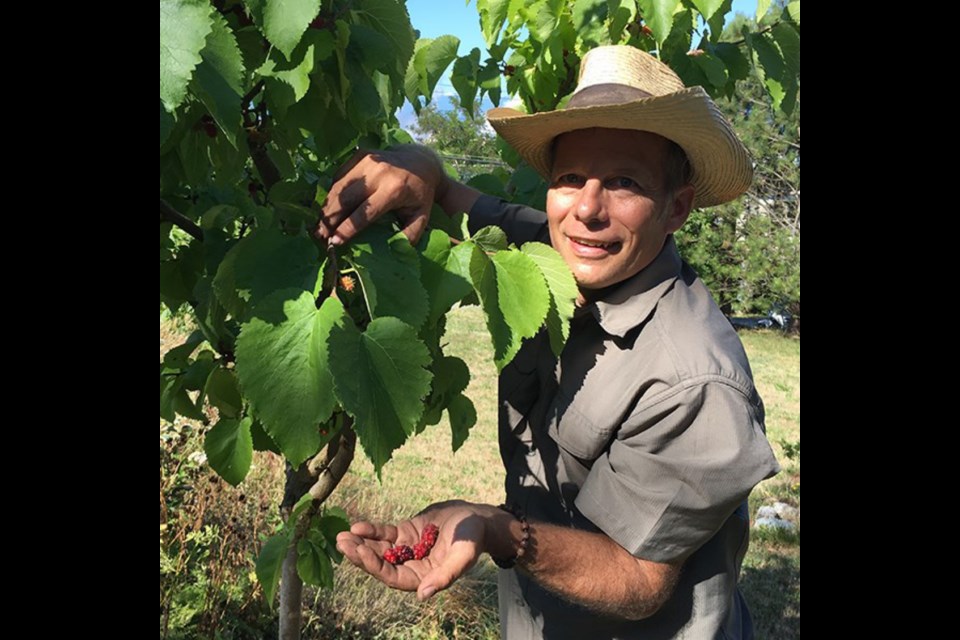Forest gardens or food forests are created using perennial plants such as fruits, berries, nuts, herbs, greens and flowers in order to utilize any size of space to make a shaded, harvestable and beautiful space in a backyard or on a patio, as well as public spaces.
For decades, permaculture expert and certified teacher Ron Berezan has been teaching individuals, groups and cities how to make a small urban yard, a community space or a large acreage farm into a self-sustaining, regenerating ecological system that produces food, attracts bees and pollinators, while at the same time mitigates changes in climate.
Harvest year-round
"A food forest is a perennial food system as opposed to an annual garden that you plant every year and arranged in a way that is similar to a forest, in that it's multi-storied; it has plants of many different types that support each other and contribute to an overall kind of forest ecology," said Berezan. "The idea is that we're creating a highly productive system that requires fewer inputs than a normal garden does, and can have all kinds of different yields or harvests from food to also medicinal plants."
Food forest in Townsite
Berezan, who is teaching a course on food forests at VIU’s tiwšɛmawtxʷ campus in mid-March, transformed a space called Sycamore Commons located at St. David and St. Paul Anglican Church in Townsite into a food forest with more than 100 species of perennial trees, shrubs and herbaceous plants along with fellow permaculturist Erin Innes in 2011.
Good for growing
"We have so many amazing choices of edible perennial species in this region, starting at the upper storeys of fruit and nut trees, that we are familiar with," said Berezan. "I really love it and not that many people grow it here, but the mulberry is fabulous. The other fruit tree often neglected is the pawpaw, which not many people have, so one can get into some of the lesser known species as well."
Blueberries, raspberries, blackberries and currents are great to plant, he added, because they are nitrogen fixing, which helps to build healthy soil.
Edible berries and greens
"Asparagus is a really great one for early harvest and is a perennial, then there are other ones like rhubarb, and edible perennial greens," said Berezan. "It's a different kind of gardening though; it's one in which one's mindset changes a little bit, in that we're trying to create a longer term, stable system that doesn't require a ton of human intervention on a regular basis."
Berezan said most of the effort goes into the original design and planning and getting things going, and if the design works well then work is reduced.
Transforming rural spaces
"I've just come back from Cuba and on part of this trip we visited a rural site about five acres in size that has thousands of plants I first saw 12 years ago when it had just been planted," said Berezan. "Now [the site] is like walking through a jungle, with massive mango, avocado trees and coffee in the understory with coconuts poking through."
Although plants grow faster in the tropics, Berezan said in reality our coastal temperate zone also has plants that grow year round.
Habitat and climate
"We lived in Edmonton before coming to Powell River, and in a few short years transformed an open-lot we were living on into a very productive, biologically diverse food forest," said Berezan. “That's the other benefit of creating this type of garden, is that they create a lot of habitat for other creatures and also sequester a lot of carbon in the process."
For Berezan, food forests are a part of food security in a community as well, but that doesn't mean he shun's the traditional vegetable garden.
"It's another piece of local food security, having a diversity of sizes and locations of highly productive food systems, which isn't to say we don't want vegetable gardens," he said. "I think [food forests] are a really good model for our region; people should know that this option is available to them."
Low maintenance growing
Berezan emphasized that not everyone has the time or energy to manage an intensive vegetable garden, so a food forest can be a good solution to that.
"There are so many properties around that are large, and plenty of one- and two-acre properties that are quite difficult to maintain for people especially as they age," said Berezan. "So making something like a food forest can be a good solution for land use that also has a lot of benefits."
Join the Peak’s email list for the top headlines right in your inbox Monday to Friday.




